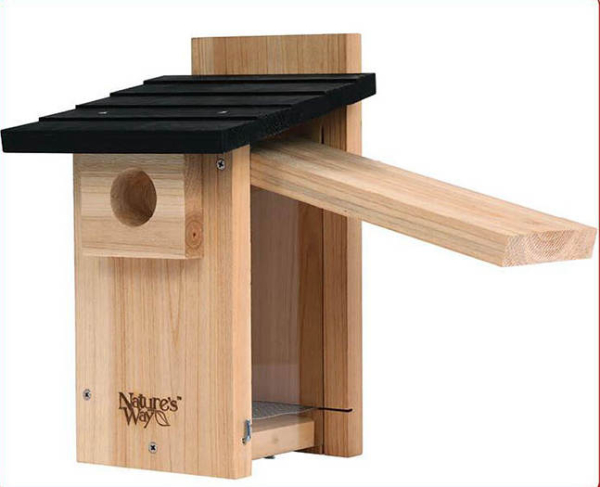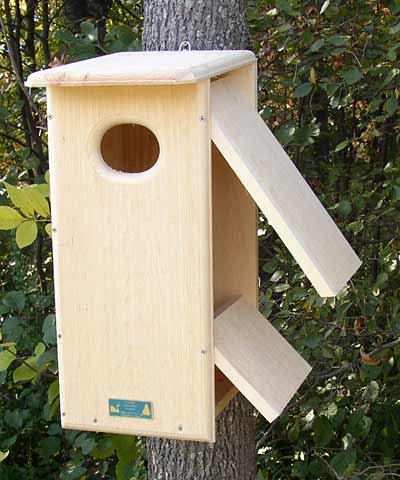
The Cedar Bluebird House with Viewing Window from BestNest is an excellent nest box option. When the side panel is raised, the unique clear plastic viewing window provides a safe view during monitoring.

The Wild Birds Unlimited EcoTough Bluebird House includes a unique two-way opening system for easy monitoring and cleaning, and it’s made of environmentally friendly high-quality recycled plastic. WBU also offers a similar EcoTough Wren & Chickadee House.

BestNest’s Coveside Wood Duck House has all the options these beautiful birds require in a big nest box.
|
It’s getting down to crunch time to prepare for cavity nesting birds, and we’ve been emphasizing that aspect of birding recently in advance of this year’s nesting season. The downward curve in our continental bird populations means we all need to make an extra effort this year to make sure our surviving birds prosper and increase for years to come. Some of our favorite backyard birds are cavity nesters, including bluebirds, wrens, chickadees, and screech owls. For a given nest box to be most effective and safe for birds to use, there are a few things to look for when buying a nest box or birdhouse.
In essence, a nest box is an artificial cavity, suitable for cavity nesting birds to build a nest in, or in the case of owls or kestrels, lay eggs in (they don’t build nests). But an appropriate nest box has some very important features that even a natural cavity may not provide. Hence, you can improve on nature by providing the right nest boxes for our birds.
Below, we provide a quick list of what to look for before you buy, or build, a nest box. An extremely useful, simply stated collection of information about each cavity nesting species and the nest box size and habitat requirements is succinctly provided at the Cornell Lab’s NestWatch website; see https://nestwatch.org/learn/all-about-birdhouses/features-of-a-good-birdhouse/
Big & Small – Consider adding a couple of small nest boxes and a big nest box to your property to benefit a variety of nesting pairs.
Entrance Size – One of the most important considerations when selecting a nest box is the size of the entrance hole. Different birds need different-sized entrances, with the intent to keep larger, more aggressive species from taking over a nest box meant for bluebirds or chickadees, for example. The NestWatch webpage listed above provides entrance sizes for all cavity nesting birds.
Open Access – One of the things missing from many nest boxes found in hardware stores and department stores is a way to access the inside of the nest box, which is imperative for cleaning, maintaining, and monitoring any nest box. Access is usually provided by a hinged side of the nest box, but also check for a sturdy closing mechanism so the opening side can’t open unexpectedly.
Ventilation & Drainage – Most nest boxes have holes or slots to provide simple ventilation on hot days as well as drainage holes on the bottom, just in case water should accumulate. Then too, if a nest box lacks these features, it’s easy to drill some sizable holes in the nest box to provide ventilation and drainage.
Base Screen – Few nest boxes have a base screen, but it is helpful to keep the nest or wood chips off the nest box floor. It’s easy to add a base screen to any nest box by cutting an appropriately sized screen using quarter-inch metal screen mesh and bending the edges to give it a half inch of elevation above the floor.
Climbing Grooves – It’s also helpful to carve grooves into the wood below the entrance inside the front panel of the nest box to create something of a ladder for hatchlings or nestlings to climb – to help duck hatchlings and other nestlings gain a toe-hold when they are ready to climb out of the nest box.
Wood Chips – It’s important to add an inch or so of wood chips to the bottom of any big nest box. Most birds that utilize big nest boxes for birds don’t build nests, notably owls and kestrels, and cavity-nesting ducks don’t really build a nest beyond the down lining the female builds around her egg clutch, so wood chips are a natural helpful addition.
Habitat Selection – Where you install a next box will probably dictate whether a certain species will select the nest box. Each species has its own habitat preferences, so check the habitat preferred by the birds you wish to attract at the NestWatch website at https://nestwatch.org/learn/all-about-birdhouses/features-of-a-good-birdhouse/
Predator Proofing – Once you have your nest box(s) picked out, think about how you will provide predator proofing, which often is most connected with how and where you install a nest box. All nest boxes need predator proofing, with an excellent example of a baffle being the Wild Birds Unlimited Raccoon Baffle that will stop raccoons, squirrels, cats, snakes, and more; see https://www.wbu.com/products/advanced-pole-system/ Attaching a long piece of stove pipe metal can also serve this purpose on larger posts or poles.
Shopping for Quality Nest Boxes
One of the best examples of a nest box that has all the details to make it a preferred product, including a base screen and a unique clear plastic viewing window inside the opening panel to easily monitor nest box activities: The Cedar Bluebird House with Viewing Window is very affordable and available from BestNest at https://www.bestnest.com/bestnest/RTProduct.asp?SKU=NWB-CWH4 along with many other nest boxes.
Another great option is the Wild Birds Unlimited EcoTough Bluebird House, which includes a unique two-way opening system for easy monitoring and cleaning, complete with ventilation and drainage openings, and constructed with environmentally friendly high-quality products made from recycled plastic; see https://www.wbu.com/products/nest-boxes/modern-rustic-bluebird-house/ – and WBU also offers a similar EcoTough Wren & Chickadee House.
BestNest has what must be the best selection of Big Nest Boxes, including the Coveside Wood Duck Box, which you can check out at https://www.bestnest.com/bestnest/RTProduct.asp?SKU=COV-10110 This nest box can also be used by small owls, kestrels, and other cavity nesting ducks, although there are specific nest boxes built with these birds in mind too.
For example, you can check out nest boxes with all the right options for owls and kestrels including the BestNest Premium Screech Owl & American Kestrel House at https://www.bestnest.com/bestnest/RTProduct.asp?SKU=BN-PSCRCH
Now’s the time to take action to benefit cavity nesting birds. Make a plan, select the best nest boxes for the birds you wish to attract, and position them so you can enjoy observing the ensuing action this spring. Providing nest boxes for birds is more important than ever!